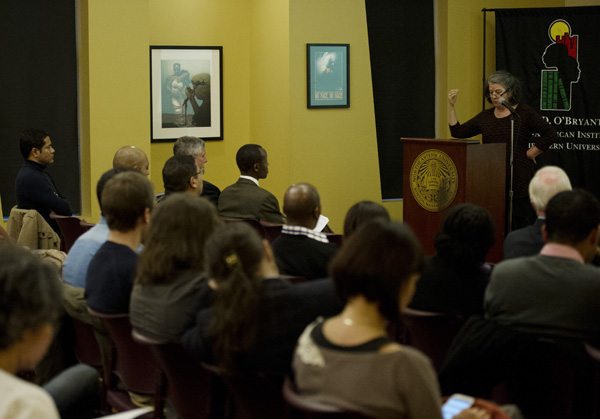Why AIDS remains a huge global problem

Some 1.1 million people in the U.S. are currently living with HIV, according to the Centers for Disease Control and Prevention, but only 25 percent receive ongoing medical care to keep the virus under control.
“We should be embarrassed by that viral suppression rate,” said Jean Flatley McGuire, a professor of the practice in the Department of Health Sciences and the former director of the Massachusetts HIV/AIDS Bureau. “To stymie the epidemic in this country, we must make sure people know their status.”
McGuire was one of a half dozen experts who discussed a series of new and evolving strategies to stem the the HIV/AIDS epidemic on Monday afternoon in the Cabral Center as part of a celebration of World AIDS Day, which is held annually on Dec. 1. She was joined by a panel of Northeastern faculty members in addition to delegates in the U.S. Department of State International Visitor Leadership Program, who have been tasked with promoting international cooperation in the fight against the spread of HIV/AIDS.
The two-hour event was co-sponsored by World Boston as well as the Bouvé College of Health Sciences, the College of Social Sciences and Humanities, and the Center for International Affairs and World Cultures.
Richard Wamai, an assistant professor of public health in the Department of African American Studies and an expert in HIV/AIDS research and policy, opened the discussion by noting the key drivers of America’s AIDS epidemic, which has killed more than 630,000 people. Some factors, he said, namely poverty and lack of condom use, mirror those found in Sub-Saharan Africa, where some 25 million people are currently living with the disease.
Wamai later noted that black youth represent half of all new HIV infections among people aged 13 to 29. “This new epidemic among African Americans in the U.S. is being forgotten,” he said, “and we need to bring it back into the political discussion.”
From there, the conversation shifted to the challenges in the international fight against HIV/AIDS. The ILVP delegates, who represented countries as far flung as Armenia and Nigeria, cited a dearth of funding and a lack of community leadership as two of the biggest obstacles.
“Funding is a challenge for all countries in Eastern Europe,” said Momchil Kostov Baev, the health programs coordinator at Center for Interethnic Dialogue and Tolerance, an NGO in Bulgaria. “I spoke to Bulgaria’s Minister of Health, and he doesn’t know how to fill the huge resource gap,” he added. “Unfortunately the money in the state budget is not enough.”
Of community leadership, he said, “Several NGOs in Bulgaria work with HIV positive patients, but they are small and weak and in great need of capacity building.”
In the Q-and-A session, Denise Horn, an assistant professor of international affairs and an expert in transnational activism, asked the panelists to discuss the efficacy of take-home HIV tests.
“Technology has improved,” said Brook Baker, a professor of law who is actively involved in campaigns for universal access to treatment, prevention, and care for people living with HIV/AIDS. “If you’re testing for the third or fourth time, why go back to the doctor’s office? As long as you know what to do if the test is positive, why have that inconvenience and extra cost?”





